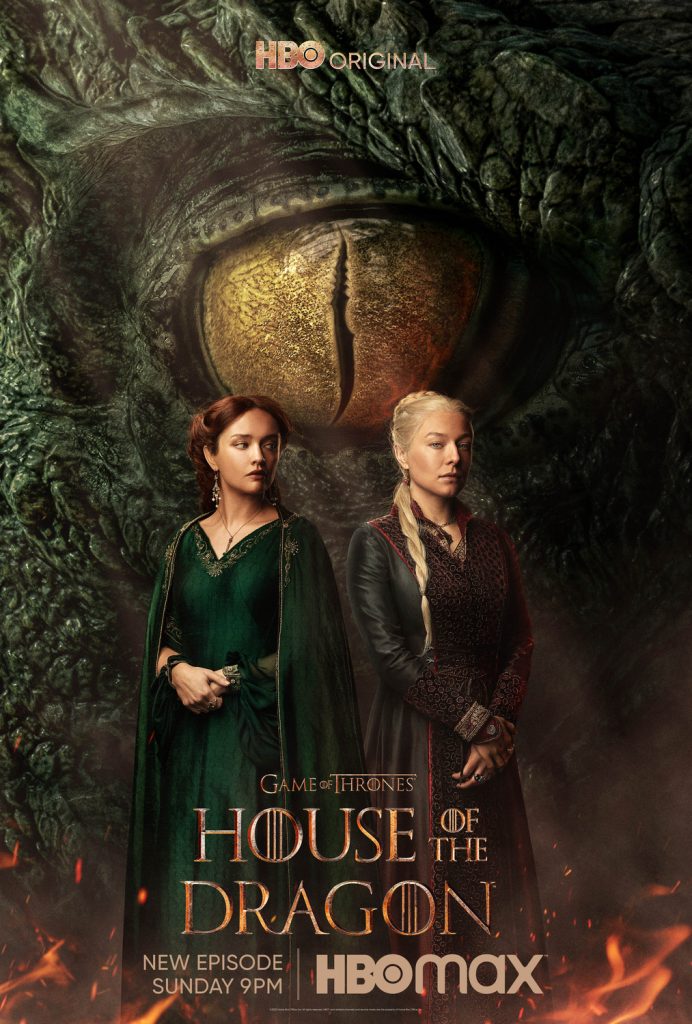In “Succession” but with more platinum hair, dragons, lords and knights, the Targaryens are back and ready to rumble.
One hundred and seventy-two years preceding the birth of Queen Daenerys, “House of the Dragon” draws viewers back into the “Game of Thrones” universe. “House of Dragon” tells the story of the fall of the Targaryen empire. While “Game of Thrones” has gained a massive cult following, fans were hesitant to watch the spin-off series as the final season had left a bitter taste.
The season starts off with the death of Aemma, King Visery’s first wife. Director Greg Yaitanes did not hold back in showing the graphic imagery of Aemma’s stomach cut open and her child pulled out of her body, all against her will while she bleeds to death. This is all done in desperation to save who would have been her only son and the heir to the Targaryen throne. While these scenes are disturbing, it conveys the message that these women are born with pain. There is a recurring theme of female pain and trauma that is also seen in “Game of Thrones.” This commentary on womanhood adds more dimension and layers to its female characters. Although Alicent is being set up to be the villain, Yaitanes allows the audience to empathize with her, as her character is complex. She is confined by her lack of choices — being pressured into seducing the king by her father, forced to have children with Viserys and not being able to maintain her friendship with Rhaenyra because of her sons. Alicent is not the perfect antagonist and Rhaenyra is not the perfect protagonist. There is no fine outlining of who the villain or hero is.
Something both “Game of Thrones” and “House of the Dragon” executes beautifully is giving rise to strong characters previously ignored. Rhaneys steps up as she assumes her son is dead and her husband is bedridden. Everything she does is meticulous and calculated. This is captured when she rides her dragon into Aegon’s crowning as a show of power but chooses not to yell “dracarys” — the command for dragons to breathe fire — as she knows it’s not her war to start. This female rise to power is reminiscent of “Game of Thrones,” notably with Daenerys.
Rhaenyra’s questionable relationships with men are a much needed break from all the politics and war. Ser Criston Cole’s character development felt like whiplash as the handsome knight, who once was in a whirlwind romance with Rhaenyra, becomes angry and bitter. “Game of Thrones” has somewhat desensitized fans from incest, so Daemon and Rhaenyra’s relationship doesn’t come much of a surprise. Yaitanes convinces viewers to even root for them as they have undeniable tension, especially when they speak high Valerian together.
There is a good use of omens that leaves room for viewers to analyze. In the first episode, Rhaenyra says, “The only thing that could tear down the House of the Dragon was itself.” This sets the tone for the rest of the season, as it had become a prophecy. Another omen is King Viserys’ cut from sitting on the iron throne. His own throne is rejecting him metaphorically and literally. He is a weak king not only in the physical sense, but he is oblivious to the schemes and motives around him, which allows chaos to ensue. The downfall of the Targaryen empire is acknowledged from the beginning, which makes the unraveling of the chaos exciting.
Although “House of the Dragon” has its highs, it falls victim to cliques and overused tropes. Specifically, the use of the miscommunication trope was frustrating to see. Alicent starts a civil war after Viserys supposedly told Alicent that Aegon should be king before he died. Viserys was in a state of delirium as he was seconds away from dying and milk of the poppy was pumping through his veins. Alicent is loyal to King Viserys and has good intentions but she feeds into her delusions. While this isn’t necessarily bad writing, it just felt trivial this deep into the story.
To add to the criticisms, the show sometimes sacrifices fully developing plot points in order to move the story along, which makes it difficult at times to comprehend what is happening. To make it more confusing, there are a lot of names being thrown around and they all sound very similar.
All in all, it was enjoyable for fans of “Game of Thrones,” otherwise it may be confusing to watch as a stand-alone show. The parallelisms between the two shows are partially what makes “House of the Dragon‘’ so sensational. Not being able to understand the context behind the families or how the events of “House of the Dragon” led to Westeros in “Game of Thrones” time might make the viewing experience less exciting. With that being said, it is still worth the watch for lovers of drama, fantasy and medieval costumes.



